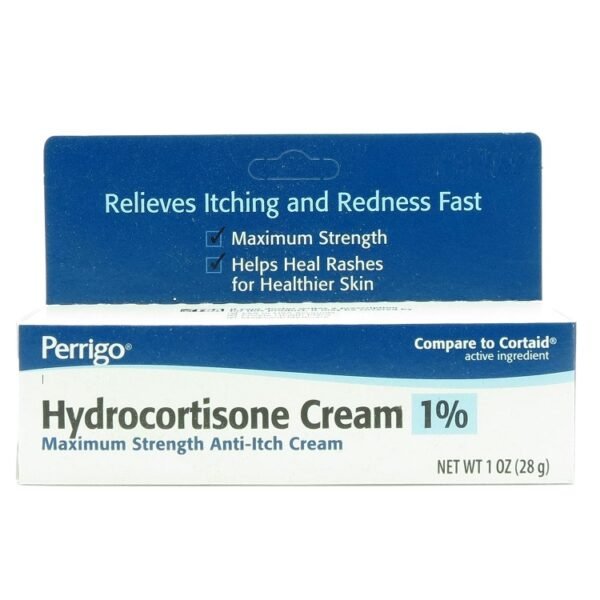Topical Hydrocortisone is used as an anti-inflammatory and anti-pruritic for the treatment of localized cutaneous and genital conditions such as eczema, anal itching, and ulcerative colitis.
Topical Hydrocortisone Uses:
Dermatoses:
- Relieving the inflammatory and itchy symptoms of dermatoses that respond to corticosteroids (eg, eczema; psoriasis; poison ivy, oak, or sumac; insect bites; minor skin irritation; mild to moderate atopic dermatitis; and seborrheic dermatitis).
Anal and genital itching (external):
- Use for external genital, feminine, and anal irritation as well as post-irradiation proctitis, cryptitis, and other inflammatory disorders of the ano-rectum.
Ulcerative colitis (adjunctive therapy):
- Adjunctive therapy for ulcerative colitis, particularly distal variants such ulcerative proctitis, ulcerative colitis on the left side, and ulcerative proctosigmoiditis, which can occasionally affect the transverse and ascending colons.
Hemorrhoids:
- Use when haemorrhoids are irritated.
Adult Topical Hydrocortisone Dose:
Dosage for external genital and anal itching: Topical:
- (1% cream) Hydrocortisone acetate:
- Apply 2 to 4 times per day to the afflicted area.
- Apply the afflicted region with the hydrocortisone base (cream, 1% gel, 1% lotion, or 1% ointment) 2–4 times each day.
Therapy of atopic dermatitis with topical hydrocortisone dosage:
- Topical: Lotion containing hydrocortisone butyrate:
- Two times each day, apply a thin coating to the afflicted region.
Therapy of corticosteroid-responsive dermatosis with topical hydrocortisone dosage: Topical:
- Hydrocortisone base (cream, solution, gel, lotion, ointment,):
- To the afflicted area, apply a thin coating two to four times each day.
- Hydrocortisone acetate (cream, lotion):
- To the afflicted area, apply a thin coating two to four times each day.
- Hydrocortisone probutate (cream):
- To the afflicted area, apply a thin coating one to two times each day.
- Hydrocortisone valerate (cream, ointment):
- To the afflicted area, apply a thin coating two to three times each day.
- Hydrocortisone butyrate (lipid, cream, ointment, solution):
- To the afflicted area, apply a thin coating two to three times each day.
Dose in the therapy of Hemorrhoids:
- Rectal:
- For two weeks, take one suppository (25 or 30 mg) twice daily.
- One suppository three times per day or two suppositories twice per day may be required for severe proctitis patients.
- Treatment for factitial proctitis might last up to 6 or 8 weeks.
Dose in the treatment of Ulcerative colitis: Rectal:
- Foam:
- Use the lowest dose possible to preserve clinical response: one applicatorful (90 mg), one to two times per day for two to three weeks, then every other day after that; reduce dosage before stopping long-term treatment
- Suspension:
Every night for 21 days or until remission, one enema (100 mg) (clinical improvement may precede improvement of mucosal integrity)
To stop long-term therapy, may take 2 to 3 months of therapy
After that, the administration should be reduced progressively to every other night for 2 to 3 weeks.
Dose in Children
Dose in the therapy of Atopic dermatitis:
Infants over 3 months, Children, and Adolescents:
- Hydrocortisone butyrate ( Locoid lotion, Locoid Lipocream,): Topical:
- Two times each day, apply a thin coating to the afflicted region.
- Reevaluate the diagnosis if there is no improvement after two weeks.
- Hydrocortisone butyrate ( Locoid lotion, Locoid Lipocream,): Topical:
Dose in the treatment of Corticosteroid-responsive dermatosis (including psoriasis):
Infants, Children, and Adolescents:
- Hydrocortisone acetate (2 percent lotion), hydrocortisone base (cream, ointment): Topical:
- Depending on the severity of the illness, apply a thin layer to the afflicted region 2 to 4 times daily. Occlusive dressings can be used to treat stubborn disorders like psoriasis.
- Hydrocortisone acetate (2 percent lotion), hydrocortisone base (cream, ointment): Topical:
Dose in the treatment of minor dermatologic irritation: OTC Labeling:
Children over 2 years and Adolescents:
- Hydrocortisone base: Topical:
- To the afflicted area, apply a thin coating three to four times each day.
- Hydrocortisone base: Topical:
Dose in the treatment of Anal and genital itching, external: OTC labeling:
Children over 12 years and Adolescents:
- Hydrocortisone base: Topical:
- To the afflicted area, apply a thin coating three to four times each day.
- Hydrocortisone base: Topical:
Dose in the treatment of mild to moderate Ulcerative colitis (induction):
Children and Adolescents: Limited data available:
- Rectal enema/suspension: Rectal:
- One or two times a day, one 100 mg enema.
- Rectal enema/suspension: Rectal:
Topical Hydrocortisone Pregnancy Category: C
- In some studies on animal reproduction, adverse events were observed.
- High doses of topical products can increase the risk of low birth weight babies.
- The systemic bioavailability of topical corticosteroids can be variable due to the use of occlusion and the integrity of the skin.
- This may be further affected by the trimester in which you are pregnant.
- The use of topical corticosteroids does not pose a significant risk to a woman's pregnancy.
- The use of topical corticosteroids may increase the risk of developing stretch marks.
- Psoriasis is treated during pregnancy with conservative treatment, just like in nonpregnant women.
- Low to moderate-potency corticosteroids should be preferred when a topical steroid needs to be used.
- Pregnant females should use mild-to-moderate potency topical corticosteroids. Large amounts of steroids or prolonged use should be avoided.
- Avoid areas with high levels of percutaneous absorption.
- Topical steroids of high potency should only be used when absolutely necessary and within the first trimester.
Hydrocortisone use during breastfeeding:
- Although topical corticosteroids can be utilised, it is advised to provide hydrocortisone with caution to nursing mothers.
- For the treatment of psoriasis, it is recommended that breastfeeding women use topical corticosteroids with low to moderate potency.
- It is unknown if hydrocortisone systemic absorption results in detectable amounts in human milk.
- Breast milk contains systemic corticosteroids.
- You should not apply any topical corticosteroids to the breasts until breastfeeding stops (Leachman 2006).
- Hypertension was observed in breastfed infants when high-potency topical corticosteroids were applied to their nipples.
Dose in Kidney Disease:
The manufacturer's labeling has not provided any dosage adjustments.
Dose in Liver disease:
The manufacturer's labeling has not provided any dosage adjustments.
Side effects of Topical Hydrocortisone:
Unfavorable local events were shown. Especially after rectal administration, adverse effects resembling those seen with systemic absorption are been reported. Also, read Hydrocortisone (Solu Cortef)
Cream, ointment:
Dermatologic:
- Pruritus
- Secondary Skin Infection
- Folliculitis
- Hypertrichosis
- Hypopigmentation
- Acneiform Eruption
- Atrophic Striae
- Perioral Dermatitis
- Maceration Of The Skin
- Miliaria
- Skin Atrophy
- Skin Irritation
- Burning Sensation Of Skin
- Xeroderma
Enema:
Hematologic & Oncologic:
- Rectal Hemorrhage
Central Nervous System:
- Localized Burning
Local:
- Local Pain
Suppositories:
Dermatologic:
- Xeroderma
- Folliculitis
- Allergic Contact Dermatitis
- Hypopigmentation
- Pruritus
Central Nervous System:
- Localized Burning
Infection:
- Secondary Infection
Contraindications to Topical Hydrocortisone:
- Ileocolostomy in the early or immediate postoperative period systemic fungal infections hypersensitivity to hydrocortisone and any ingredient of the formulation (rectal suspension)
- Obstruction, abscess, and peritonitis.
OTC labeling
- Do not use self-medication with it to treat diaper dermatitis.
- There is not much evidence of cross-reactivity between corticosteroids and allergenic corticosteroids.
- Cross-sensitivity is possible due to similarities in chemical structure or pharmacologic effects.
Warnings and precautions
Suppression of the adrenals:
- The hypothalamic-pituitary-adrenal (HPA) axis may be suppressed or hypercortisolism may occur, especially in younger individuals or those who receive large dosages for extended periods of time.
- The adrenal crisis might be brought on by the suppression of the HPA axis.
Ocular disease:
- Patients with cataracts or glaucoma should be cautious; patients who have experienced increased intraocular pressure, cataracts, and glaucoma with long-term use of the device should be aware.
Osteoporosis
- Patients with osteoporosis should be cautious.
Anaphylactoid reactions
- Patients who have received corticosteroids have had rare cases of anaphylactoid reactions.
Contact dermatitis:
- It's possible to get allergy contact dermatitis. Instead of clinical aggravation, the failure of healing is typically used to diagnose it.
- If irritation does develop, stop using it and seek immediate medical attention.
Thyroid disease:
- The state of thyroid illness is critical.
- Changing thyroid health may need changing the dose. Patients with hyperthyroidism had a greater metabolic clearance of corticosteroids than those with hypothyroidism.
Ulcerative colitis
- It is possible to delay surgery for severe ulcerative colitis while you wait for treatment.
Immunosuppression:
- Corticosteroids can worsen and prolong viral infections, raise the risk of secondary infections, hide acute illnesses (including fungal infections), and reduce the effectiveness of vaccines.
- Refrain against getting chicken pox or the measles. Never use corticosteroids to treat ocular herpes simplux.
- When treating viral hepatitis, fungal infections, or cerebral malaria, corticosteroids should not be utilised.
- Latent TB or tuberculosis reactive patients should be constantly watched.
- Only allow fulminating and disseminated TB to be active, together with antituberculous medication.
- Before initiating corticosteroids, it is important to rule out amebiasis in patients who have recently traveled to tropical climates.
Kaposi Sarcoma:
- Kaposi Sarcoma can be caused by prolonged treatment with corticosteroids (case reports). If this is the case, it should be discontinued.
Myopathy
- Acute myopathy has been associated with high doses of corticosteroids in individuals with neuromuscular transmissible diseases. There may be injury to the respiratory or ocular muscles.
Hepatic impairment
- Patients who have cirrhosis or a damaged liver should exercise caution.
Myasthenia gravis:
- Patients with myasthenia gravis should be cautious.
Myocardial Infarction
- Take care after an acute myocardial injury (MI); corticosteroids can cause myocardial damage.
Psychiatric disorders:
- Corticosteroid abuse can cause personality changes, depression, euphoria and insomnia.
- Corticosteroid treatment can worsen preexisting mental disorders.
Sensitization:
- Local sensitization has been connected to the usage of topical creams (redness or irritation). If you have any sensitivity, stop immediately.
Systemic effects
- Percutaneous absorption of topical corticosteroids is possible.
- The absorption of topical corticosteroids can lead to Cushing syndrome, hyperglycemia or glycosuria.
- Application to broad regions, extended application to skin that hasn't been denuded, and the use of occlusive dressings can all boost absorption.
Cardiovascular disease
- Patients with hypertension and/or heart failure should be cautious.
Diabetes:
- Patients with diabetes mellitus should be cautious.
Gastrointestinal Disease:
- Patients with GI disorders (diverticulitis and intestinal anastomoses), should be cautious.
Renal impairment
- Patients with impaired renal function should be cautious; fluid retention could occur.
Hydrocortisone (topical): Drug Interaction
Risk Factor C (Monitor therapy) | |
Corticorelin | The therapeutic benefit of corticorelin may be reduced by corticosteroids. In particular, recent or ongoing corticosteroid medication may reduce the plasma ACTH response to corticorelin. |
Deferasirox | Corticosteroids may intensify Deferasirox's negative/toxic effects. Particularly, there may be a higher risk of GI bleeding or ulcers. |
Ritodrine | Corticosteroids may intensify Ritodrine's harmful or hazardous effects. |
Risk Factor D (Consider therapy modification) | |
Hyaluronidase | Corticosteroids may diminish the therapeutic effect of Hyaluronidase. Management: Patients receiving corticosteroids (particularly at larger doses) may not experience the desired clinical response to standard doses of hyaluronidase. Larger doses of hyaluronidase may be required. |
Risk Factor X (Avoid combination) | |
Aldesleukin | The anti-cancer effects of corticosteroids may be diminished by aldesleukin. |
Monitoring parameters:
- serum glucose levels, electrolytes, blood pressure, weight, the occurrence of an infection, monitoring of IOP with treatment lasting more than six weeks, and children's growth
How to administer Topical Hydrocortisone?
Topical cream, lotion, ointment:
- To clean, dry skin, apply a thin coating, and then gently massage it in.
- Before usage, give the lotion a good shake.
Rectal suppository:
- Rectal suppository foil should be removed, and the pointed end should go in first.
- Do not hold unwrapped suppositories for an extended period of time.
Rectal foam:
- Before using, shake ferociously for 5–10 seconds.
- When using, keep the cap on.
- To fill the applicator, keep the container upright.
- Put the applicator tip in the anus with care.
- Don't use anything from the aerosol canister other than the applicator that the manufacturer supplies; only use that.
- After each usage, rinse the applicator with warm water.
Rectal suspension:
- Firmly shake the bottle.
- The applicator tip's protective sheath should be removed.
- Lay on your left side with your right leg contracted and your left leg extended.
- Pointing the greased applicator tip slightly in the direction of the navel, gently enter it into the rectum.
- Squeeze the bottle carefully and firmly to inject the medicine.
- Immediately after administration, remove and discard the used unit.
- Spend at least 30 minutes in the position.
- If you can, keep using the enema all night.
Mechanism of action of Hydrocortisone:
- Topical corticosteroids are vasoconstrictive, anti-inflammatory, and anti-pruritic.
- Histamine, liposomal enzymes, and kinins are a few examples of endogenous chemical mediators that can have their production, release, or activity reduced.
- This is achieved through phospholipase A inhibitory protein (lipocortins) induction and successive suppression of arachidonic acid release.
- The potency of hydrocortisone is low to medium (dosage form dependent)
Metabolism:
- Hepatic
Absorption:
- It is possible for topical corticosteroids to enter the body through the skin.
- The formulation and use of occlusive dressings, epidermal integrity (whether the skin is intact or abraded), and other factors all affect how much harm has been done.
- Topical steroids are more readily absorbed via the skin in newborns (particularly preterm newborns), babies, and young children.
- More topical medicines are absorbed by the rectus than through the skin. Systemic consequences are therefore more common.
Excretion:
- Urine (major);
- bile
International Brand Names of Topical Hydrocortisone:
- Hydrocortisone Max St
- Hydrocortisone Max St/12 Moist
- HydroSKIN
- Medi-First Hydrocortisone
- Ala Scalp
- Ala-Cort
- Anti-Itch Maximum Strength
- Anucort-HC
- Anusol-HC
- Aquanil HC
- Beta HC
- Colocort
- Cortaid Maximum Strength
- Cortenema
- Corticool
- Curad Hydrocortisone
- MiCortHC
- NuCort
- Pandel
- Pediaderm HC
- Preparation H Hydrocortisone
- Procto-Med HC
- Procto-Pak
- Proctocort
- Proctosol HC
- Instacort 5
- Locoid
- Locoid Lipocream
- Med-Derm Hydrocortisone
- Proctozone-HC
- Recort Plus
- Rectacort-HC
- Rederm
- Sarnol-HC
- Scalacort DK
- Scalacort
- Scalpicin Maximum Strength
- Texacort
- Westcort
- Barriere-HC
- Topide
- Alfacort
- Alfason
- Allerderm
- Biocort
- Calmiox
- Calmurid
- Colifoam
- Cort Dome
- Cortifoam
- Advanced Allergy Collection
- Dermasorb HC
- GRx HiCort 25
- Hemmorex-HC
- Hydrocortisone in Absorbase
- Cortaid Cream
- Cortic-DS
- Cortenema
- Cortifoam
- Cortoderm
- Emo Cort
- Hyderm
- Hydroval
- NOVO-Hydrocort
- Prevex HC
- Sarna HC
- Cortider
- Cortiderm
- Cortileb
- Cortopin
- Delster
- Derm-Aid
- Dermacrin HC Lotion
- Dermocare
- Dervacort
- DHAcort
- Dilucort
- Dioderm
- Eczacort
- Efcortelan
- Efficort
- Egocort
- Hc45
- Hidrotisona
- Hikomicron
- Hipoge
- Hovicor
- Hydcort
- Hydrotopic
- Hysone
- Hytisone
- Hytone Lotion
- Intasone
- Lacticare HC
- Lacticare-HC
- Lactisona
- Laticort
- Latycort
- Lexacorton
- Locoid
- Locoid Lipo
- Locoidon
- Lycor
- Medrocil
- Mylocort
- Netracort
- Nutracort
- Nutraderm
- Nutrasona
- Pandel
- Plancol
- Riacort
- Sicacort H
- Sigmacort
- Topicort
- Unicort
- Westcort
- Hyde
- Hydracort
- Hydrocort
- Hydrocortisyl
- Hydroderm
- Hydrokortison
- Hydrosone
- Youzhouer
- Zocort
- Zona
Topical Hydrocortisone Brand Names in Pakistan:
Hydrocortisone Ointment 1 %W/W in Pakistan | |
| Hycortisone | Mediceena Pharma (Pvt) Ltd. |
Hydrocortisone Cream 1 %W/W in Pakistan | |
| Clozole-H | Pearl Pharmaceuticals |
| Cortiderm | Valor Pharmaceuticals |
| Cortiderm | Valor Pharmaceuticals |
| Cutis-Hc | Derma Techno Pakistan |
| Gen-Cot | Biogen Pharma |
| Hydrocort 1.0% | Atco Laboratories Limited |
| Hydrocort 1.0% | Atco Laboratories Limited |
| Hydrocortisone | Zafa Pharmaceutical Laboratories (Pvt) Ltd. |
| Hydrogray | Gray`S Pharmaceuticals |
| Hydroheal | Webros Pharmaceuticals |
| Hydrosone | Ferozsons Laboratoies Ltd. |
| Hydrovate | Pearl Pharmaceuticals |
Hydrocortisone Cream 2 %W/W in Pakistan | |
| Cortival | Valor Pharmaceuticals |
| Hydrosone | Ferozsons Laboratoies Ltd. |
Hydrocortisone Cream 2.5 %W/W in Pakistan | |
| Hydrocort 2.5% | Atco Laboratories Limited |




